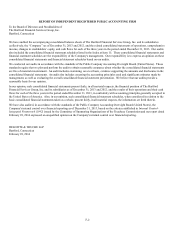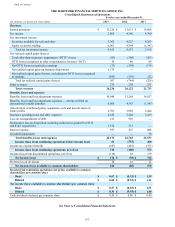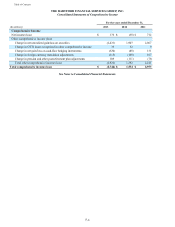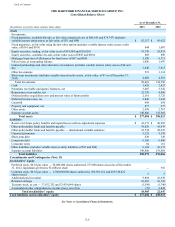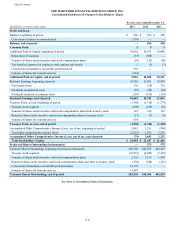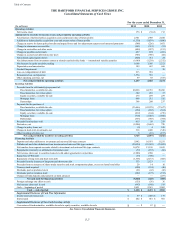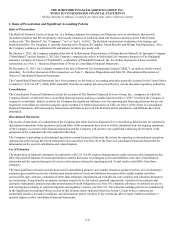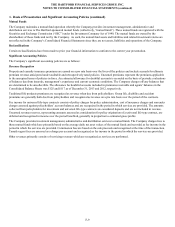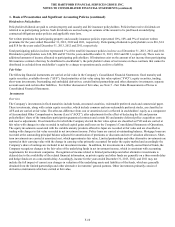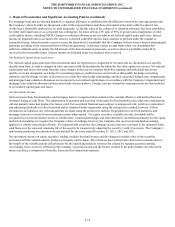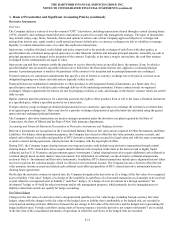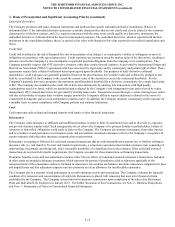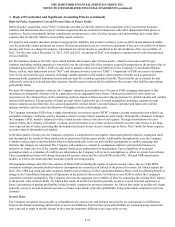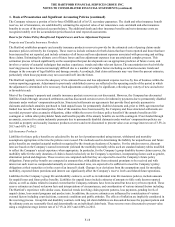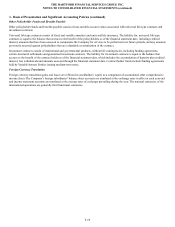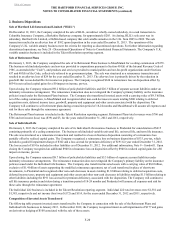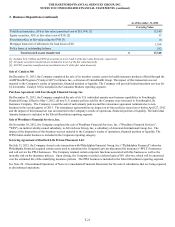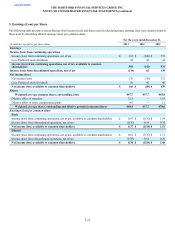The Hartford 2013 Annual Report Download - page 148
Download and view the complete annual report
Please find page 148 of the 2013 The Hartford annual report below. You can navigate through the pages in the report by either clicking on the pages listed below, or by using the keyword search tool below to find specific information within the annual report.THE HARTFORD FINANCIAL SERVICES GROUP, INC.
NOTES TO CONSOLIDATED FINANCIAL STATEMENTS (continued)
1. Basis of Presentation and Significant Accounting Policies (continued)
F-12
For mortgage loans that are deemed impaired, a valuation allowance is established for the difference between the carrying amount and
the Company’s share of either (a) the present value of the expected future cash flows discounted at the loan’s effective interest rate,
(b) the loan’s observable market price or, most frequently, (c) the fair value of the collateral. A valuation allowance has been established
for either individual loans or as a projected loss contingency for loans with an LTV ratio of 90% or greater and consideration of other
credit quality factors, including DSCR. Changes in valuation allowances are recorded in net realized capital gains and losses. Interest
income on impaired loans is accrued to the extent it is deemed collectible and the loans continue to perform under the original or
restructured terms. Interest income ceases to accrue for loans when it is probable that the Company will not receive interest and principal
payments according to the contractual terms of the loan agreement. Loans may resume accrual status when it is determined that
sufficient collateral exists to satisfy the full amount of the loan and interest payments, as well as when it is probable cash will be
received in the foreseeable future. Interest income on defaulted loans is recognized when received.
Net Realized Capital Gains and Losses
Net realized capital gains and losses from investment sales are reported as a component of revenues and are determined on a specific
identification basis, as well as changes in value associated with fixed maturities for which the fair value option was elected. Net realized
capital gains and losses also result from fair value changes in derivatives contracts (both free-standing and embedded) that do not
qualify, or are not designated, as a hedge for accounting purposes, ineffectiveness on derivatives that qualify for hedge accounting
treatment, and the change in value of derivatives in certain fair-value hedge relationships and their associated hedged asset. Impairments
and mortgage loan valuation allowances are recognized as net realized capital losses in accordance with the Company’s impairment and
mortgage loan valuation allowance policies previously discussed above. Foreign currency transaction remeasurements are also included
in net realized capital gains and losses.
Net Investment Income
Interest income from fixed maturities and mortgage loans is recognized when earned on the constant effective yield method based on
estimated timing of cash flows. The amortization of premium and accretion of discount for fixed maturities also takes into consideration
call and maturity dates that produce the lowest yield. For securitized financial assets subject to prepayment risk, yields are recalculated
and adjusted periodically to reflect historical and/or estimated future repayments using the retrospective method; however, if these
investments are impaired, any yield adjustments are made using the prospective method. Prepayment fees on fixed maturities and
mortgage loans are recorded in net investment income when earned. For equity securities, available-for-sale, dividends will be
recognized as investment income on the ex-divided date. Limited partnerships and other alternative investments primarily use the equity
method of accounting to recognize the Company’s share of earnings; however, the Company also uses investment fund accounting
applied to a wholly-owned fund of funds. For impaired debt securities, the Company accretes the new cost basis to the estimated future
cash flows over the expected remaining life of the security by prospectively adjusting the security’s yield, if necessary. The Company’s
non-income producing investments were not material for the years ended December 31, 2013, 2012 and 2011.
Net investment income on equity securities, trading, includes dividend income and the changes in market value of the securities
associated with the variable annuity products previously sold in Japan. The returns on these policyholder-directed investments inure to
the benefit of the variable annuity policyholders but the underlying funds do not meet the criteria for separate account reporting.
Accordingly, these assets are reflected in the Company’s general account and the returns credited to the policyholders are reflected in
interest credited, a component of benefits, losses and loss adjustment expenses.


